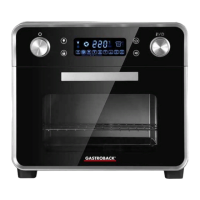EN EN
26 27
holds especially, when using the Air Fry function. For coating, use a pastry brush
or pour a little cooking oil into a bowl, and toss your food therein.
• Always ensure to leave approx. 3 cm (1 1/4 inches, width of a teaspoon) of
free space to the heating elements. When operating the oven at high tempera-
ture (above 180°C/360°F), you should leave a larger distance. This holds for
dishes, spits and other utilities as well.
• At high temperature the baking process is speeded up at any parts that are near
the heating elements. Thus, selecting another shelf slot has a high influence on
the results (see: ‘Properties of Your New Oven / 3 Shelf Slots’). In general, the
crust will be more even with a larger distance to the heating elements.
• After a prolonged time of storage, your food may get dry and therefore the crust
gets brown quickly or even burns. Some types of fruit or vegetables can be soa-
ked in cold water for up to 30 minutes before baking. This may compensate
the loss of water during storage. If it is compatible with your recipe, add some
lemon juice to the water. Other types of food (e.g. fish) may be coated with
some cooking oil.
• When you prepared your food with a marinade or paste containing large
amounts of sugar or proteins, the crust may get brown quickly, when a high
temperature is set. In this case, it may be crutial for getting the desired results to
select a significantly lower temperature and increase the baking time. Supervise
the baking process closely.
• Due to the heat radiation of the heating elements, convection is usefull in any
cases. Therefore, the convection fan cannot be switched off. Adapt the settings
for your dishes accordingly. In most cases, you should decrease the temperature
by 20-30°C (40-60°F) in comparison to baking without convection.
• If food could drip during cooking (e.g. when using the grilling rack, wire basket,
or rotisserie spit), we recommend to insert the baking tray in the bottom shelf slot
for protecting the heating elements and crumb tray. It is easy to clean the baking
tray due to the non-stick coating. However, you may coat the baking tray with
tin foil or baking paper.
NOTE
If required, the baking tray and grilling rack can be pushed into the same shelf
slot simultaneously.
WARNING – Do not place any sheats of foil or paper directly onto the
heating elements or onto the crumb tray. This may cause overheating and fire!
SPECIAL NOTES FOR BAKING MEAT
• For closing the pores of meat and holding back the juices, when baking meat
within a baking dish (e.g. roaster, cooking brick), you should preheat the baking
dish within the oven at high temperature, before placing the meat in it. Alterna-
tively, sauté the meat in a frying pan from all sides, before baking.
• Meat should have room temperature, before you place it in the oven.
• The baking time of a piece of meat depends on the thickness, the type of meat,
and the oven temperature. You may use a cooking thermometer to always get
the same results. Penetrate the cooking thermometer into the thickest part of the
meat for checking the core temperature. The optimum core temperature is bet-
ween 65°C (150°F; rare) and 75°C (170°F; well done). Poultry should reach
a core temperature of 85 °C (190°F).
• The higher the temperature of the oven the more weight the roast will loose. With
normal convection, 130°C (°F) will do.
• If the roast has no crust or is still to light in colour at the outside after the desired
core temperature is reached you may turn up the temperature of the oven to 175-
200°C (350-410°F) and bake the meat for a few minutes. Keep an eye on the
browning process to avoid burning the crust. If required, you may use the Air
Fry function for this task too.
• When the meat is done you can keep it warm for 25-45 minutes by turning the
oven to 70°C (160°F).
SUITED BAKING DISHES
Baking dishes made of metal (aluminia, stainless steel), oven-proof glass, and fire-
proof ceramics or stoneware can be used in your oven. Please consider, that the
glaze or coatings of some baking dishes are not suited for high temperature usage.
Adhere to the manufacturer's instructions.
WARNING – Do not use any containers that could burst, melt, or become dis-
torted, to avoid hazard due to splinters, liquids running out, and harmful substances.
IMPORTANT - It may be possible to use a small cooking brick. However, cooking
bricks may burst, when heated up too fast or uneven. Therefore, when using
this oven, it is required to heat it up carefully in several steps and keep a larger
distance to the heating elements. If possible, insert the baking tray and the grilling
rack simultaneously in the bottom shelf slot to protect the cooking brick from the
heat radiation of the bottom heating elements. Then place the cooking brick on
the grilling rack.

